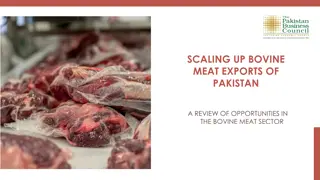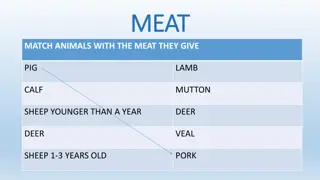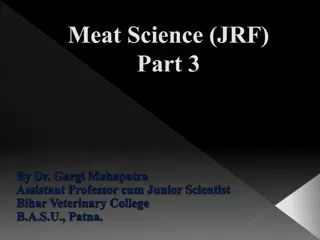Meat Processing Equipment Market to Reach $22.6 Billion by 2031
Meat Processing Equipment Market by Type (Cutters, Mixers and Blenders, Massagers, Tumblers, Tenderizers, Slicers) Mode of Operation (Semi-automatic, Automatic), Category (Processed Meat, Fresh Meat), Meat Type (Beef, Chicken) - Global Forecast to 2031
2 views • 4 slides
Meat Processing Equipment Market - Global Opportunity Analysis and Industry Forecast (2024-2031)
Meticulous Research\u00ae\u2014a leading global market research company, published a research report titled, \u2018Meat Processing Equipment Market by Type (Cutters, Mixers and Blenders, Massagers, Tumblers, Tenderizers, Slicers) Mode of Operation (Semi-automatic, Automatic), Category (Processed Mea
8 views • 3 slides
Meticulous Research® Releases Comprehensive Report on the Global Vegan Meat Market
Vegan Meat Market Size, Share, Forecast, & Trends Analysis by Product (Burger Patties, Meat Balls, Sausages), Source (Soy), Meat Type (Chicken, Beef, Fish), Storage Category (Frozen), Distribution Channel (B2B, B2C {Modern Groceries}) - Global Foreca
1 views • 4 slides
Plant-Based Meat Market Strengthens with Rising Flexitarian Diets
Plant-Based Meat Market by Source (Soy, Pea, Wheat, Blends, And Other Sources), By Meat Type (Chicken, Pork, Beef, Fish, and Other Meat Types), By Product Type (Burgers, Patties, Sausages, Other Product Types), By End-User, By Region and Companies -
2 views • 4 slides
Preservation Methods for Meat and Poultry: A Comprehensive Overview by Dr. R. K. Jaiswal
Dr. R. K. Jaiswal discusses the principles and methods of preserving meat, emphasizing the importance of preventing spoilage. Topics include drying, freeze-drying, salting, curing, low and high-temperature preservation, and more. The article explores historical practices, modern techniques, and the
0 views • 44 slides
Understanding Meat Processing: From Ancient Techniques to Modern Innovations
Meat processing involves various methods such as curing, smoking, canning, cooking, and more to alter fresh meat for consumption. The practice has evolved from ancient civilizations like the Egyptians and Romans to modern times, focusing on improving shelf life, flavor, and nutritional value of meat
2 views • 10 slides
Innovative Value-Added Meat Products by Dr. Sushma Kumari
Enrobing and incorporating seasonal vegetables in meat products, restructuring less valuable meat, and creating various meat products like ham, bacon, sausages, and more are methods used to enhance the quality, flavor, and healthfulness of meat products, as outlined by Dr. Sushma Kumari, Assistant P
0 views • 13 slides
Meat Processing and Product Formulation
Explore the formulation and development of common meat products such as meat balls, patties, and pickles. Learn about the ingredients, ratios, preparation methods, and packaging techniques involved in creating these popular meat items.
2 views • 13 slides
Understanding Meat Processing Techniques and Procedures
This article discusses the processing of meat and meat products, including basic and advanced procedures such as comminution, emulsification, and curing. It delves into the importance of size reduction, emulsions, and stable meat emulsions in enhancing the quality and characteristics of meat product
0 views • 21 slides
Modern Meat Processing Techniques: Comminution and Beyond
Explore modern meat processing techniques such as mincing, milling, and chopping for the comminution of meat, resulting in improved texture and quality of meat products. Learn how uniformity in size, breaking up connective tissues, and binding lean meat with fat enhance the appeal and desirability o
0 views • 11 slides
Importance of Meat Hygiene and Sanitation in the Meat Industry
Meat hygiene is essential to ensure the safety and suitability of meat for consumers. It involves implementing specific standards and regulatory actions to maintain cleanliness and prevent contamination at all stages of production. Proper cleaning and sanitization practices, adherence to legal stand
0 views • 16 slides
United States Food Safety and Inspection Service: Ensuring Meat and Poultry Products' Safety
The United States Department of Agriculture's Food Safety and Inspection Service (FSIS) oversees the federal inspection of meat and poultry products to ensure their safety for human consumption. The statutes governing this process include the Federal Meat Inspection Act, the Poultry Products Inspect
0 views • 23 slides
Plant based meat market 4
The changing lifestyles and an increasing number of health-conscious consumers are increasing the popularity of plant-based meat products, positively impacting the demand for plant-based meat.
1 views • 4 slides
Understanding the Spoilage Flora in Raw Meat Products
Raw meat products are highly perishable due to the presence of various spoilage bacteria, yeasts, and molds. Factors such as nutrient availability, oxygen levels, storage temperature, and pH influence the predominant spoilage flora in meat. Psychrotrophic bacteria thrive in refrigerated storage, lea
0 views • 17 slides
Opportunities for Scaling up Bovine Meat Exports in Pakistan
Pakistan's bovine meat export sector has potential for growth, with a focus on chilled bovine meat. The country currently holds a limited share in the global market, exporting mainly to GCC countries, Afghanistan, and Vietnam. Within the GCC market, Pakistan has significant market share in both chil
0 views • 21 slides
Quality Evaluation of Meat Products by Dr. Sushma Kumari: A Comprehensive Overview
Explore the intricate details of evaluating the quality of meat products in the field of Meat Science. From physico-chemical properties to microbiological qualities and sensory evaluation, this presentation covers essential aspects such as pH, emulsion stability, spoilage identification, and sensory
0 views • 20 slides
SAMPA's TME Testing Program for Quality Meat Products
SAMPA conducts TME tests to ensure consumers receive quality processed meat products that meet minimum standards of quality. The Total Meat Equivalent (TME) is a measure of product quality defined in SANS 885. Testing is done by Food Consulting Services using NIR technology. SAMPA decides what produ
0 views • 9 slides
Plant based meat market 4
The changing lifestyles and an increasing number of health-conscious consumers are increasing the popularity of plant-based meat products, positively impacting the demand for plant-based meat. The growth of the plant-based meat market is mainly attri
1 views • 4 slides
Understanding Meat Microbiology: Challenges and Growth Phases
Meat microbiology is a crucial aspect of food science, focusing on organisms present in red meat, poultry, fish, and their products. This field addresses both preventing food spoilage and protecting consumers against foodborne illnesses. Challenges arise from slaughtering to home consumption, where
0 views • 124 slides
Case Study of Human Trichinosis in Texas Region
Human trichinosis is a parasitic disease caused by consuming undercooked or raw meat infected with Trichinella larvae. This case study details the presentation, diagnosis, and treatment of a 36-year-old female physician from San Angelo, Texas, who manifested symptoms after consuming bear meat from A
0 views • 22 slides
Understanding Different Types of Meat and Poultry
This informative content delves into the world of meat and poultry, discussing various types, structures, nutritive value, and uses. From red and white meat to game animals, it covers the diversity of options available in markets and highlights processed products like canned meat and sausages. Learn
0 views • 34 slides
Exploration of Meat Preservation Techniques from Various Cultures
This project delves into the science and tradition of meat safety and preservation, focusing on beef jerky as a counterpart to traditional Native American dried meats. It includes activities like preparing jerky, evaluating salt's impact on preservation, and sensory testing. Additionally, it explore
0 views • 23 slides
2017 Retail Cuts Iowa 4-H/FFA Meat Judging Contest - Image Gallery
Showcasing a collection of images from the 2017 Retail Cuts Iowa 4-H/FFA Meat Judging Contest, this gallery provides visual insights into the competition. The images capture various aspects of the contest, offering a glimpse into the world of meat judging in Iowa. From different cuts of meat to the
0 views • 32 slides
Red Cross Shelter Partnership Initiative in Missouri
The Red Cross supports a Faith-Based Organization (FBO) Initiative in Missouri, inviting organizations to assist primarily in sheltering efforts for disaster response in the community. The National Shelter System shows numerous Red Cross shelters in Missouri, with advantages to partnering with the R
0 views • 16 slides
Veganmodernism: The Future of Meat Abolition and Technological Disruption
Explore the vision of Veganmodernism for meat abolition, the shifting technology landscape, the current and future costs and impacts of animal products, and the projected peak in global meat production. Delve into a future where modern food products outshine animal-derived foods both in quality and
0 views • 26 slides
Overview of Meat Industry Prospects in India
The meat industry in India holds significant prospects with a large livestock population, ranking high in goat, buffalo, sheep, and cattle numbers globally. The country has seen developments in modern abattoirs and meat production statistics. Animal food is noted for its high-quality nutrients compa
0 views • 21 slides
Understanding the Importance of Flavor in Meat Science
Flavor plays a crucial role in meat quality perception, with tenderness and juiciness following closely behind. Consumers prioritize specifically cooked meat flavor for acceptance. Understanding flavor compounds and the difference between taste and flavor is vital in meat palatability. The five basi
0 views • 22 slides
Understanding Quality Grades of Meat
Quality grades of beef are based on factors like marbling, tenderness, and age of the animal. Grades range from Prime to Cutter, influencing the meat's flavor and juiciness. Lamb and poultry also have quality grades, while pork is not graded by the USDA due to its consistent tenderness. Assessing ma
0 views • 33 slides
Beginner Farmer Meat Marketing Analysis & Strategies
Explore pricing strategies, market channels, and financial goals for beginner farmers in profitable meat marketing. Learn to identify desired profit, determine pricing per channel, and select viable sales avenues. Analyze market observations and plan sales projections for different meat types. Disco
0 views • 19 slides
Modern Meat Processing Techniques: Comminution, Milling, Chopping
The modern meat processing techniques involve comminution of meat cuts to enhance texture and quality. Mincing, milling, and chopping are key processes that help in achieving uniformity, texture, and binding of meat products. Different technologies such as meat mincers, millers, and choppers are uti
0 views • 11 slides
Explore Different Types of Meat and Poultry Products
Discover the various types of meat and poultry products, including pork, veal, lamb, mutton, deer, and more. Learn which animals provide different cuts of meat such as sausages, bacon, leg of lamb, and fillet steak. Delve into the world of poultry with options like duck, turkey, chicken, and pigeon,
0 views • 9 slides
Methods of Meat Preservation and Drying Techniques
Meat preservation is crucial to prevent microbial spoilage during distribution and storage. Methods include physical (drying, refrigeration, heat) and chemical (salting, smoking) techniques. Drying meat reduces water content, inhibiting microbial growth while prolonging shelf life. Various drying me
0 views • 33 slides
Understanding the Ageing Process of Meat in Meat Processing
Ageing of meat is a crucial process in meat processing that involves holding unprocessed meat at specific temperatures to enhance tenderness and flavor. This process, also known as ripening or conditioning, triggers physical and chemical changes in protein structure, collagen, and proteolysis. Diffe
0 views • 11 slides
Food Production, Packaging & Careers in Meat Industry
This presentation covers the production, packaging, and careers in the meat industry, focusing on red meat products from cattle, sheep, and pigs. It delves into the utilization of various parts of animals, processes in abattoirs ensuring safety and humane treatment, as well as the versatility and so
0 views • 24 slides
Understanding Meat Adulteration and Substitution in Food Processing
In meat processing, there is a risk of substituting lower quality meats for higher quality ones to deceive consumers. Differentiating between animal meats is crucial, especially in minced or sausage forms. Horseflesh, with its high glycogen content, presents a unique challenge. Methods for meat spec
0 views • 7 slides
Understanding Animal By-products in Meat Science Research
This article delves into the realm of animal by-products in meat science, exploring their categorization and diverse uses in various industries such as food, pharmaceuticals, and cosmetics. From secondary products like Hoof/Feet and horns, thyroid glands, to bones, this comprehensive guide sheds lig
0 views • 22 slides
Processing of Meat Products: Comminuted and Non-Comminuted
Comminution is a key process in the production of meat products, involving the mechanical reduction of raw materials to create various textures suitable for different products like sausages. This process results in a range of products from coarsely minced meats to finely emulsified sausages like fra
0 views • 19 slides
Meat Preservation Techniques and Storage Methods
Preserving meat is essential to control spoilage and extend its shelf life. Factors like temperature, pH, moisture content, and packaging play crucial roles in meat storage. Methods such as chilling, freezing, curing, smoking, canning, and drying are commonly used to preserve meat, each offering uni
0 views • 8 slides
WEND-100 Implementation Guidelines Report to IRCC14 Denpasar, Bali, Indonesia + VTC (Hybrid Meeting)
IHO Resolution 1/2021 introduces the WEND-100 principles, with complementary guidelines detailing their implementation for S-1XX products. The report discusses the applicability of WEND-100 principles for S-100 based products, focusing on specific S-1XX products planned for release before S-101. It
0 views • 12 slides
Utilizing Litchi Fruit Pericarp Extract as a Natural Antioxidant in Meat Products
Oxidation is a major concern in meat products affecting quality and shelf life. This study explores the potential of litchi fruit pericarp extract as a natural antioxidant in sheep meat nuggets to combat lipid oxidation. Litchi fruit pericarp, often discarded as waste, is rich in phenolics with anti
0 views • 17 slides







































